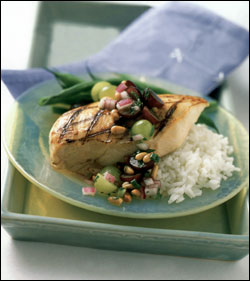Books about food are no more immune from the gusts of the zeitgeist than books about politics or the stock market. While 2002 was the year of Comfort Food, of curling up and turning our backs on the cold cruel world outside, 2003 is turning out to be the year of Back to Basics: not just how-to-boil-water basics but basics in the Casablanca sensethe fundamental things that apply no matter how fickle the flow of fashion as time goes by. We think every book covered here is, in its individual way, a keeper: a reliable, permanent source of culinary inspiration for days dark or sunny.
Roger Downey
Northwest Best Places Cookbook by Cynthia Nims (Sasquatch Books, $19.95 paperback)
In 2001, Cynthia C. Nims and Kathy Casey compiled a Best Places Seattle Cookbook with recipes from the city’s outstanding restaurants and barsa nifty addition to Sasquatch Books’ Best Places guidebook series. Now the resourceful Nims stalks the perfect recipe among the inns and restau- rants of Washington, Oregon, and British Columbia. It’s a lovely collection, and not just for the recipes, which are stellar. Even more than the recipes, one is impressed with the lightness, variety, and inventiveness of Northwest chefs blessed with an abundance of fresh seafood, game, and produce. Fabulous vegetarian wild mushroom, leek, and wild rice cakes from Port Townsend’s Silverwater Cafe (although the accompanying Dijon sauce makes hollandaise look spartan); spinach soup with cilantro from Whitehouse-Crawford in Walla Walla; Northwest seafood pepper pot from Christine’s in Eastsound; Andalusian flank steak from Langley Cafe. If you don’t have time for a road trip, this is the next best thing. LUCILLA
Cooking by Hand by Paul Bertolli (Clarkson Potter, $40 hardcover)
Less a cookbook than a series of philosophical essays on food supplemented by illustrative examples, Paul Bertolli lays out a new way of looking at food and its handling in the kitchen; a new way based on ways that were old when European pioneers first arrived on this continent. In the first paragraph of his first chapter, Bertolli describes an encounter in Florence with a plate of ribollita, a humble bean-and-cabbage soup enlivened with a spritz of virgin olive oil. Bertolli had tasted the dish before, “but never with such a clear sense of the original intention of the dish.” Every recipe in Cooking by Hand is inspired by a search for origins and intentions, by the desire to clear our perceptions of the classic dishes as an art historian cleans a painting or a statue to reveal the original textures and colors beneath the grime of centuries. For Bertolli, the “grime” is, as often as not, the restless itch of chefs seeking novelty and, thereby, acclaim. Bertolli proposes, in his colorful phrase, to “clean the fresco,” to rediscover the ultimate essence of a ripe tomato, of freshly ground corn meal for polenta, of hand-rolled pasta and hand-stuffed sausage. Cooking by Hand is not a book to be absorbed in one sitting or a dozen sittings. It’s a book to be sampled, savored, experimented with, set aside and challenged, then returned to in humility. R.D.
Zingerman’s Guide to Good Eating by Ari Weinzweig (Houghton Mifflin, $19.95 paperback)
Zingerman’s Delicatessen has lines out the door in winter. Michigan winter. If you want your home (or, perhaps better yet, your friends’ homes) to resemble Ari Weinzweig’s legendary Ann Arbor deli, you might consider plunking down 20 bucks for his 480-page cookbook/kitchen guide/gastronomic almanac/food-appreciation treatise.
Weinzweig is certainly a man who knows what “good eating” means; he keeps his little culinary empire (the deli, the creamery, and the bake house) stocked with the very best imported, domestic, and local foods. A Reuben I had at the deli years ago still haunts me, so ne plus ultra were the sauerkraut, corned beef, cheese, and bread. In the Midwest, Zingerman’s is a holy temple for true-blue foodies, the Scarecrow Video of cuisine.
In addition to simply disclosing dozens of Zingerman’s recipes, the Guide investigates broader issues surrounding the food in question. Compared to the pragmatism of a paella recipe, an inquiry titled “Why Spanish Rice Is Special” may seem excessively academic. Fortunately, the personal touch Weinzweig applies while discussing foods he adores, like Spanish Cabrales cheeseor outlining his culinary pet causes, such as an ardent campaign for darker-crusted breadrecalls a certain Mr. Douglas in our neck of the woods.
But unlike the Dahlia big- wig’s recent Big Dinners book, Weinzweig’s text gets into the nuts and bolts of buying, keeping, and using excellent food. Instead of assuming the reader knows what jamón serrano is and how it’s used, Weinzweig provides an informative (but never patronizing) lesson in how to employ it creatively while still respecting the cultural heft of the ham.
Regional differences in salami, comparative vinegar shopping, and figuring out what to do with varietal honey are other topics that get the scholarly treatment from Weinzweig, with offbeat illustrations increasing the levity factor and making the Guide accessible as well as highly edifyingand therefore a perfect gift for anyone who enjoys a side of know-how with their chow. NEAL SCHINDLER
The Slow Mediterranean Kitchen by Paula Wolfert (John Wiley, $34.95 hardcover)
Before hummus, before couscous, before every foodie’s pantry boasted half a dozen olive oils, Paula Wolfert was preaching the gospel of simple, healthy Mediterranean fare. Before “slow food” became a buzzword, Wolfert embodied an ideal of earthy food handmade from local seasonal ingredients. Now, in her seventh book (the other six are still in print), she brings it all back home in a collection of recipes that could serve as a primer of healthy eating, a crash course in food as antifad, as a sacrament of life. For all the depth of tradition behind this assemblage of slow-cooked North African, Levantine, Turkish, and southern European flavors, there’s not one recipe that doesn’t bear a characteristically surprising Wolfert twist or a hint in its terse, witty introduction that will make you a better cook of whatever you set out to prepare. I’d call The Slow Mediterranean Kitchen the culmination of a life’s work, but I fully expect Wolfert’s eighth book to top this one. That’s the kind of culinary force of nature she is. R.D.
The New France: A Complete Guide to Contemporary French Wine by Andrew Jefford (Mitchell Beazley, $45 hardcover)
For generations, the best writing about wine has come from countries where the vine doesn’t grow, above all England. Andrew Jefford carries on in the grand tradition of wine writers like Edmund Penning-Rowsell, Hugh Johnson, and Jancis Robinson. Wine for him is not just a beverage but a touchstone of civilization, and a touchstone, moreover, polished to its highest luster in France. The New France is not just a valuable guide to the less- familiar byways of French winemaking but a book with a thesis. Jefford believes that the rising challenge of new viticultural areas like Australia, South Africa, and the New World has been nothing but good for French wine, because it has forced the younger generation of winemakers to question, rethink, and experiment with a tradition that, for all its triumphs, had become hidebound and smug. For American readers, the book’s greatest value is in its meticulous survey of the new wines of quality from ancient regions like Roussillon and Languedoc, but Jefford has just as much to say about younger and sometimes heretical growers and vintners in the belly of the grand vin beast, in the Médoc, Burgundy, even Champagne. An inspiring book, which will anchor many a wine library for years to come. R.D.
Aquavit and the New Scandinavian Cuisine by Marcus Samuelsson (Houghton Mifflin, $45 hardcover)
Quick: What do you think of when you hear the words “Swedish cuisine”? Exactly: meatballs. Or pickled herring, dill pancakes, maybe beets. Probably not kaffir lime, garam masala, and ketjap manis. Marcus Samuelsson, born in Ethiopia, adopted by Swedes, raised in Göteborg, and now chef of New York’s hot new restaurant Aquavit, keeps the essence of traditional Swedish food and techniqueslots of seafood, game, vegetables pickled and cured but transforms them with influences from Asia, the Caribbean, and South America. The results are bewitching: crispy tempura seafood in a beer batter laced with lime, soy, Tabasco, and dill and served with a citrus aïoli of Dijon mustard, garlic, lemon, lime, almonds, balsamic vinegar, and potatoes.
Samuelsson’s steamed crab rolls start a lot like Thai rice-paper rolls but incorporate that same yummy citrus aïoli and are served warm with tomato-mustard jam. Duck breasts are marinated with cardamom pods and cinnamon and roasted with both, along with two cups of coffee beans. It gets bettergravlax-cured tuna served on a papaya salad; miso-cured monkfish with carrot-ginger broth; braised red cabbage with ginger, cinnamon, port, and garam masala. It all sounds a bit much, but Samuelsson shows Swedish restraint. His food is subtle, never showy, every ingredient serving the essential flavor of the food. (And yes, you will find Swedish meatballs and pancakes with lingonberry sauce.) LUCILLA
The Bread Bible by Rose Levy Beranbaum, (W.W. Norton, $35 hardcover)
The title says it all: The Bread Bible is a big book, filled with history, drama, essential knowledge, character-building advice, encouragement, and tips for success. The incredibly thorough Rose Levy Beranbaum revolutionized how we bake cake in her previous best seller, The Cake Bible. Now she does the same for bread: quick breads, flatbreads, artisan breads, breads sweet and savory, austere and indulgent. Her recipesenticingly described and clearly explainedare equally useful to the novice or the experienced baker.
Her signature bread, Heart of Wheat, tweaks traditional whole-wheat recipes by omitting the bran and keeping the germ for a crunchy, chewy, ever so slightly sweet bread. Fresh herbs peek through a thin and crispy top crust in the focaccia layered with fresh herbs. Monkey bread drips with rum, raisins, and pecans. But, my oh my, if you only bake one thing in your life, make it the potato flatbread pizza. It’s a revelation . . . at once crispy, chewy, flavorful, and perfect. There is a recipe for a single flatbread or six for a crowd, with as many suggested toppings. I made the single recipe (a snap thanks to instant yeast) and topped it with her onion, spinach, and mushroom topping. As my lucky guest and I devoured it, we immediately planned to make the six-flatbread recipebut not, I fear, for a crowd. The bread is far too good, and we are far too greedy. LUCILLA
From My Mexican Kitchen: Techniques and Ingredients by Diana Kennedy (Clarkson Potter, $40 hardcover)
Years ago, I tried to learn how to cook Mexican food, but I was quickly intimidated. So many chiles, dried and fresh; herbs I couldn’t find; and, let’s face it, lard. Even though I purchased Diana Kennedy’s excellent The Cuisines of Mexico, I never felt at home with the ingredients or techniques, and my Mexican food experiences stayed mainly in Mexican restaurants. Now comes Kennedy’s wonderful new book, From My Mexican Kitchen, and I wish I had access to a time warp. It’s the book I wish Kennedy had published 30 years ago: a marvel, an indispensable companion to anyone interested in Mexican cuisine.
The first half takes you through every possible ingredient from cuitlacoche (corn fungus) to Mexican greens and spices, cheeses and cream, cooking fats and oils, rice, beans, and pasta. There are 43 pages just on chiles, each with a color photograph and detailed instructions on use, preparation, and storage. The second half is a cooking tutorialantojitos, moles, sauces, tamales, even vinegarbeautifully illustrated and clearly explained. The recipes, while delectable, aren’t really the point here. There are just enough to help you master the techniques and keep you wanting more. And you will want moremole poblano, Oaxacan chile strips in lime juice, sopes, panuchos with pickled onion, enchiladas verdes, gorditas and . . . and . . . banana vinegar! LUCILLA
The Smithsonian Sustainable Seafood Cookbook by Carole C. Baldwin and Julie H. Mounts (Smithsonian Books, $35 hardcover)
Pretty much everyone knows that many of the once-abundant food fish in the oceans have been harvested beyond their capacity to regenerate. But not many of us, standing in front of the fish counter, can say with confidence which of the tasty morsels on display are in good supply, dwindling, or on the edge of vanishing. This handsome book does double duty: It’s a guide to the marine species that, because of farming or careful stewardship, can be eaten without guilt; and it’s a fine basic survey of how seafood fits into the kitchen philosophy of today’s environment- and-waistline-conscious chefs. Even old kitchen hands will find useful tips for dealing with such newfangled seafood as tilapia, farmed eel, and sturgeon, opah and grenadier fish, amberjack and mackerel, and butterfish and shad. R.D.
Wines of South America by Monty Waldin (Mitchell Beazley, $40 hardcover)
Name the part of the world that comes in second (after Europe) for wine production. The United States? Wrong. Australia? Wrong again. Oh, shucks, you’ve probably guessed already, but it’s still pretty astonishing, right? Even more astonishing is that Monty Waldin’s attractive and informative book is the first serious treatment of its subject, covering not just Uruguay (Uruguay?), but Bolivia (Bolivia?!), Brazil, Peru, and Venezuela. Obviously, one needs to be pretty deep into the arcana of wine to dig a book so specialized; but only a few years ago, Australia, New Zealand, and South Africa were considered arcane, and look at them now. If you’ve a serious wine maven on your gift list, this book’s almost sure to hit the sweet spot. R.D.
Bistro Cooking at Home by Gordon Hamersley and Joanne McAllister Smart (Broadway Books, $35 hardcover)
I hate people who pick up an appealing word and stick it on something they want to sell you, regardless of its origin or present meaning. Gordon Hamersley calls his Boston restaurant a bistro, so that makes anything he cooks there “bistro cooking,” right? Wrong. In France, a bistro is any simple, unpretentious eatery. There’s no such thing as “bistro cooking,” only cooking in bistros. Grrr.
OK, I’m over it. Bistro Cooking at Home is a collection of dishes unified by the themes of simple cooking, one-dish cooking, stovetop cooking, and stick-it-in-the-oven-and-forget-it cooking. Most are appetizing and all are practical, which is by no means the case with many cookbooks based on a restaurant bill of fare. And the book is pretty to look at and efficiently laid out. It’s a good book. I’ll probably use it a lot. Maybe with masking tape over the title. R.D.
Leslie Mackie’s Macrina Bakery and Cafe Cookbook: Favorite Breads, Pastries, Sweets and Savories by Leslie Mackie, Andrew Cleary, and Carol Field (Sasquatch Books, $29.95 hardcover)
A morning at Macrinaif you can find a tableis a great antidote to Seattle’s dreary winter days. Enter the cozy Belltown cafe, and you are immediately beguiled by an array of arguably the best baked goods in town: muffins, cookies, tarts, scones, cakes, pizzettas, and breadslots and lots of breads. The only problem is that you want to eat them all. The same applies to the dishes in the Macrina Cookbook. You want to make them all. In this compact, friendly cookbook, Mackie shares her passion for baking and her recipes. Nearly all the favorites are herethe chewy rustic potato bread, crunchy whole wheat walnut cider bread, sourdough loaves, Casera bread, the lemon tart, cherry almond scones, the corn chowder, the essential fried egg sandwich, and a truly phenomenal steamed chocolate pudding cake. I could go on, but I must bakeeverything. LUCILLA




